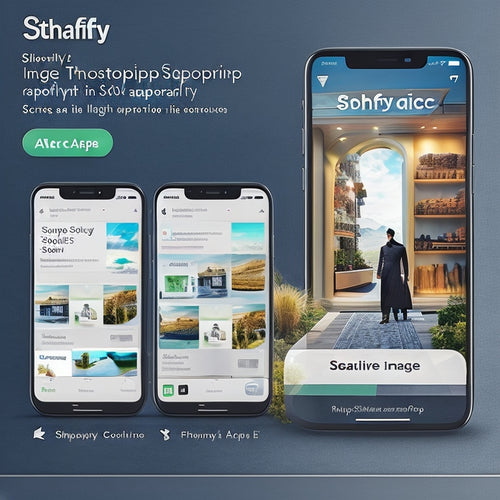
Digital Products to Maximize Ecommerce Conversions
Share
You're likely losing out on 25% of potential revenue due to suboptimal ecommerce conversion strategies. To maximize conversions, identify and fix conversion rate killers like slow loading times and non-mobile-friendly sites, which can lead to a 7% loss in conversions for every 1-second delay. Implement personalized product recommendations to save up to 63% of abandoned carts, and use tactics like upselling and cross-selling to boost average order values by 15-20%. Streamline checkout experiences, leverage social proof, and optimize product page elements to further increase conversions. By implementing these strategies, you'll be one step closer to revealing your full revenue potential.
Key Takeaways
• Identify conversion rate killers through customer behavior analysis and prioritize fixes for slow loading times and non-mobile-friendly sites.
• Implement product recommendations for abandoned carts using email retargeting, product bundles, and dynamic pricing to save up to 63% of sales.
• Optimize product pages with high-quality images, concise descriptions, verified customer reviews, and clear CTAs to influence 90% of online shoppers.
• Streamline checkout experiences by simplifying form fields, offering guest checkout, and displaying clear shipping options to reduce abandonment.
• Leverage social proof strategically through influencer partnerships, customer testimonials, and user-generated content to build trust and increase conversions.
Identifying Conversion Rate Killers
Pinpoint the conversion rate killers lurking in your ecommerce site by analyzing customer behavior, because a single misstep can send your sales plummeting.
You can't fix what you don't measure, so delve into your analytics to identify the pain points that are driving customers away.
Are your mobile responsiveness issues causing frustration on smaller screens? You're not alone - 53% of mobile users abandon sites that take over 3 seconds to load.
Speaking of loading times, every second counts. A 1-second delay can result in a 7% reduction in conversions.
You can't afford to lose customers due to slow loading times or a non-mobile-friendly site. Identify these conversion rate killers and prioritize fixes to maximize your ecommerce conversions.
Product Recommendations for Abandoned Carts
By leveraging product recommendations, you can rescue up to 63% of abandoned carts, saving thousands of dollars in potential revenue. It's a staggering statistic, and one that highlights the importance of having a solid strategy in place to win back would-be customers.
To maximize the impact of your product recommendations, consider the following tactics:
-
Email retargeting: Send personalized emails to cart abandoners with tailored product recommendations based on their browsing history and purchase behavior.
-
Product bundles: Offer complementary products to customers who've abandoned their carts, increasing the average order value and encouraging them to complete their purchase.
-
Dynamic pricing: Use real-time pricing strategies to offer customers limited-time discounts or promotions, creating a sense of urgency and encouraging them to complete their purchase.
- Upselling techniques: Use product recommendations to upsell or cross-sell relevant products, increasing the average order value and enhancing the overall customer experience.
Boosting Average Order Values
On average, a 10% increase in average order value can lead to a 25% boost in revenue, making it an important metric to optimize for ecommerce success.
You can achieve this by implementing effective cross-selling strategies and upselling techniques. For instance, you can suggest complementary products to customers based on their purchase history or browsing behavior. This can increase the average order value by 15-20%.
Additionally, you can use pricing psychology to your advantage by offering tiered pricing or limited-time discounts. This can create a sense of urgency and encourage customers to add more items to their cart. Discount strategies such as 'buy one get one free' or '20% off orders over $100' can also incentivize customers to increase their order value.
By implementing these strategies, you can increase your average order value and ultimately boost your revenue. Remember, every extra dollar added to the cart can make a significant difference to your bottom line.
Streamlining Checkout Experiences Matter
You can shave off a whopping 20% of cart abandonments by streamlining your checkout experience, making it an essential step in converting browsers into buyers. By simplifying the process and reducing friction, you can significantly increase conversions and revenue.
Here are 4 key strategies to optimize your checkout experience:
-
Simplify form fields: Reduce the number of form fields to minimize typing and make it easier for customers to complete their purchase.
-
Implement guest checkout: Allow customers to checkout without creating an account, reducing the likelihood of abandonment.
-
Display clear shipping options: Provide transparent shipping costs and estimated delivery times to alleviate uncertainty and anxiety.
- Offer secure payment options: Give customers confidence in your checkout process by offering trusted payment methods like PayPal and Apple Pay.
Personalized Product Offers Work
Tailored product offers that speak directly to individual customers' needs and preferences can boost conversions by as much as 10% and increase average order value by 15%.
You can achieve this by leveraging data and analytics to create customized promotions that resonate with your target audience. For instance, you can use customer purchase history and browsing behavior to create tailored recommendations that are relevant to their interests.
This approach helps to build trust and increases the likelihood of customers making a purchase.
Leveraging Social Proof Strategically
By incorporating social proof strategically into your ecommerce strategy, you can tap into the 70% of online shoppers who are more likely to make a purchase based on customer reviews and ratings. This is an essential element in building trust and credibility with potential customers.
Here are four ways to leverage social proof effectively:
-
Influencer partnerships: Partner with influencers who've a strong following in your target market to showcase your products and build credibility.
-
Customer testimonials: Display customer testimonials and reviews prominently on your website to build trust and showcase social proof.
-
User generated content: Encourage customers to share photos or videos of them using your products, and showcase this content on your website and social media channels.
- Social media engagement: Engage with your customers on social media, respond to their comments and concerns, and showcase your brand's personality to build a loyal following.
Optimizing Product Page Elements
Nearly 90% of online shoppers make purchasing decisions based on product page elements, making it important to optimize these components to maximize ecommerce conversions. You need to get it right to drive sales and revenue.
Here are some key elements to focus on:
| Element | Importance | Optimization Tip |
|---|---|---|
| Product Images | 85% | Use high-quality, 360-degree views to showcase products from different angles |
| Product Description | 75% | Write concise, benefits-focused descriptions that highlight unique selling points |
| Customer Reviews | 70% | Display verified customer reviews and ratings prominently on the page |
| Call-to-Action (CTA) | 65% | Use a clear, contrasting CTA that stands out from the rest of the page |
| Product Videos | 60% | Incorporate product demos or unboxing videos to showcase product features |
Frequently Asked Questions
Can Ai-Powered Product Recommendations Replace Human Curation Entirely?
You're wondering if AI can fully replace human curation, but here's the reality: while AI excels at scalability, it often lacks ethics and personalization, making human oversight essential for building trust and driving conversions.
How Do I Ensure Seamless Integration With My Existing Ecommerce Platform?
You're trying to avoid a 'house of cards' situation, where your new AI-powered recommendations collapse under integration issues. Guarantee seamless integration with your ecommerce platform by checking integration compatibility, staying on top of platform updates, and prioritizing data migration for a smooth user experience.
What Is the Ideal Frequency for Sending Personalized Promotional Emails?
You'll find the sweet spot for sending personalized promo emails by segmenting your list, A/B testing frequencies, and tracking customer engagement and ROI. Aim for a cadence that boosts conversions without-fatiguing your audience.
Can I Use Social Proof Strategies for Low-Traffic or New Ecommerce Sites?
"Fake it till you make it" doesn't apply here. You can still leverage social proof on low-traffic sites by partnering with micro-influencers, displaying trust badges, and showcasing user-generated content and customer reviews to build credibility and drive sales.
Are There Any GDPR Compliance Issues With Using Customer Testimonials?
You need to guarantee GDPR compliance when using customer testimonials, as it affects data privacy and customer trust; obtain explicit consent, anonymize data, and provide opt-out options to maintain transparency and build trust with your audience.
Related Posts
-
How Do Shoppable Videos Contribute to an Enhanced Customer Experience?
In today's digital age, businesses are constantly seeking innovative ways to enhance the customer experience. One su...
-

Essential SEO Apps for Shopify: Boost Your Store's Visibility
This article explores the significance of SEO apps for Shopify stores in enhancing visibility and ranking in search ...
-

Analytics Shopify Apps Provide Merchants With Vital Insights Into Store Performance and Sales Metrics
This article examines the significance of analytics Shopify apps in providing merchants with essential insights into...

